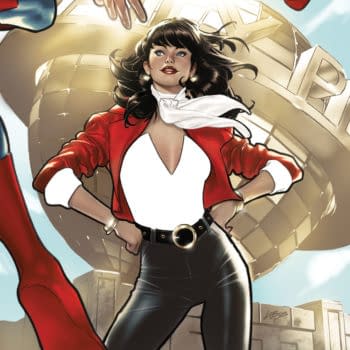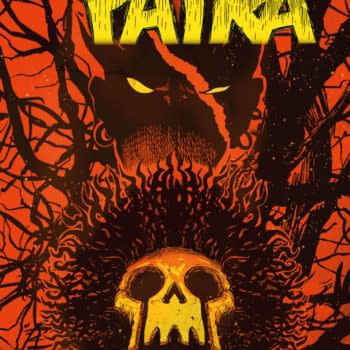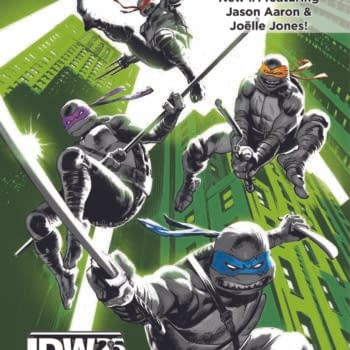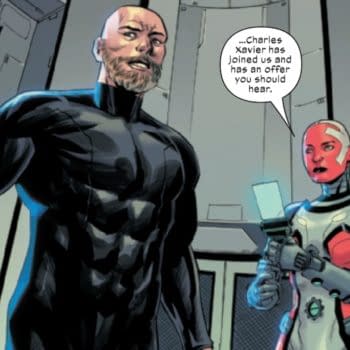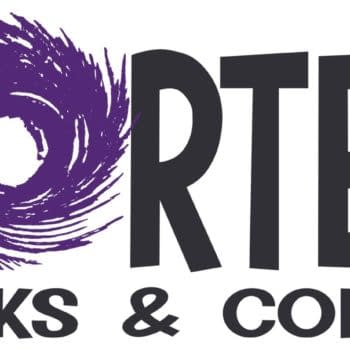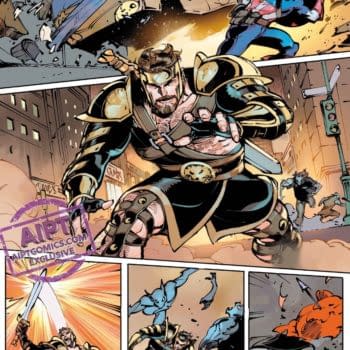Posted in: Comics | Tagged: Comics, eccc, Laura Allred, madman, mike alred
Mike And Laura Allred – Making A Monster Out Of Madman

This year marks the 20th anniversary of Mike Allred's Madman, a landmark that he's celebrating in style with a huge 11×17 hardcover collection — the Madman 20th Anniversary Monster! — which features a new story from Allred (with trademark colours from his wife, Laura Allred) and contributions from some of the biggest names in the comics field. I caught up with the Allreds after the close of the Emerald City Comicon — where they had entertained a constant stream of fans all weekend — to look back on 20 years of their signature creation.
Can you talk a little about the early inception of the character of Madman, and how you developed him?
Mike Allred: I had been doing kind of an umbrella title called Grafik Musik that I wanted as a title where I could tell a story any way I wanted, much in the same way as Love and Rockets does. With that I had a whole mix of characters from different genres and my favourite became a character named Frank Einstein, who was a "modern Prometheus" — so the Frankenstein's monster, but with contemporary sensibilities. My kids were becoming school age and they would tell their friends what I did for a living and they wanted to know what I did. At that point, I didn't really have anything that they would like, and I started to look at a lot of stuff that I loved as a kid, and it made me want to have that same sense of joy. So, that was the recipe of the title I wanted to do. I took my favourite character at the time, put a costume on him and made him into an adventurer — and that was Madman.
Was it always the intention that he was then going to be your signature character — your Maggie Chascarillo, your Cerebus — who would define you and would run for as long as you could?
MA: Oh no, not at all. In fact, he was originally called The Spook. I wanted all the meanings of the word to be challenging, if not controversial, and there was even a file with the intent to use on the copyright for the name. Kevin Eastman had picked it up for Tundra and it was going to be a three-issue series. Then it was called The Goon for a few weeks, and I even made a logo for it…but then reading Catcher in the Rye, I was inspired to call it Madman. I did the three-issue series and it did really well, but at that point Kevin stopped publishing Tundra and Bob Shreck took me to Dark Horse, to Mike Richardson, and we started up with Madman Comics. At that point, when they made it even way more successful, only then did I think that it would be something I could do for a very long time.
When you began to work on the character as a continuing series, he seemed to change a lot in terms of the philosophies and the cosmology that were informing the writing. Was that a reflection of how you were changing as a person?
MA: I wouldn't acknowledge it at the time but, in retrospect, he obviously became more and more an alter-ego for myself — at least as far as reflecting my search for existential answers, and theories of life and creation. Because he was essentially this creature that was learning things anew — he had a previous existence, yet he was very childlike as he learned new things. I felt that way too. I had had a previous career and was starting a whole new hope for success in the comic book industry. Being a young clother, being married as a teenager — there were all these things that I was reflecting on and used Frank Einstein as my filter.
You've been quite open about your Mormon faith — you've even drawn an adaptation of The Book of Mormon. Had you always been part of the faith, or did you arrive at it later as part of that existential search for meaning that you mentioned? Do your beliefs inform Frank?
MA: That also was subconscious. My parents got divorced, which is extremely rare in the Mormon Church. I think there's like a five-percent divorce rate for couples that have been married in the Mormon Temple —
Laura Allred: I think before, but not now.
MA: — but, you know, just ridiculously successful. So, for my parents to get divorced, there was almost a shame to it. My older brother and younger brother went with my mom who went back to where she grew up, back in the Rocky Mountains by Salt Lake City. I stayed in Oregon with my dad who was a psychologist and worked at the hospital that One Flew Over the Cuckoo's Nest was based on. Ken Kesey was his orderly. At that point — I hate to admit it — it was really fun, just me and dad. In a lot of ways, though, I kind of raised myself, and we had stopped going to church at this point, around when I was 11. A lot had been instilled in me, even though I didn't practice the faith. Then, several years ago, my aunt gave me the journal of my great-great-grandfather who knew Joseph Smith — the prophet of the Mormon faith — and from New York, he went with Joseph Smith everywhere he went. Smith gave him a sword that's in our family, and I didn't know any of this stuff! My aunt is really into genealogy and ancestry, so reading this journal to find out that my great-great-grandfather Reddick Allred went across the plains with Brigham Young, all the way to Salt Lake City where they — this is amazing to me — they were persecuted — there were families burned out of their homes. Even getting through the Rockies, he wrote about Indians shooting arrows at him and at one point an arrow shot him in the chest, but he had these big buttons on his shirt that saved his life, and was able to return fire before the native American was able to reload. And I'm reading this, just amazed. He was polygamous — I'm a product of his second wife of three. It made me want to really investigate what this was.
So, I took it very seriously and studied it. It inspired me to illustrate it, because the Book of Mormon is actually a fascinating text, if not sacred, it's still incredibly interesting. I wanted to determine how real it was — was it this amazing work of fiction, or was it real? I get a lot of spiritual life from it, and it's simply a thousand-year history of this family that leaves Jerusalem 600 years BC, build a ship to sail to the Americas then, over a generation, they keep a record on these plates which are ultimately abridged on golden plates by the prophet Mormon. In that history, the resurrected Christ comes to America and teaches the same things that he teaches in the New Testament, then this people called the Nephites fall out of righteousness 400 years later and are killed off — supposedly who we now know as the Mayans and Aztecs. It's essentially a thousand-year history with all these adventures and wars and philosophies and love stories. Then, in the centre of it, Jesus Christ shows up as a resurrected being. Just on that alone, I found it interesting and was just begging to be illustrated, so I took on the challenge. It's kind of like Lord of the Rings with Jesus in it.
That's fascinating. What year would that be that you were given these journals, and really began to investigate that history?
MA: Let's see… it would be early 2002, maybe?
OK, so not too long ago — right around the time you were on a break from Madman, probably?
MA: Yeah, I was doing X-Force and X-Statix, because it was immediately after that, that I had a window to try to try to adapt it and focus on that.
Speaking of focus, it often feels like Madman is kind of like a playground for your experiment. It seemed like when you were doing your run on X-Statix, a lot of the techniques you had developed in Madman had directly fed into that title. Is that how you view the project — almost like your journal, or your sketchbook?
MA: Yeah, absolutely. In fact, doing a monthly book leaves very little time to fill sketchbooks and play. So, I play with my professional work. It's my opportunity to experiment and grow and try to progress. At the same time, I have to be conscious of being consistent. For instance, in iZombie, there's a couple of issues where I think I pushed my experiments too far and they're not as consistent as the other issues. So, I'm still trying to grow and find new things to do…and with Laura, too. In fact the process that Laura's come to now — I had an idea at two o'clock in the morning, and shook her awake, saying, "What if we did this?" — she was able to play around with it and that evolved into the way we do the colours now. So, really, only the past year or so do I feel that we've reached a plateau that satisfies me on the level that I've striving for my whole career.
I'd like to talk to you a little bit now, Laura. You've been a huge, almost inseparable part of Mike's art with your colouring, for as long as I've been reading his work. Did you always have ambitions to work in comics this way, or is this something you've fallen into as a result of your relationship with Mike?
LA: I started painting when I was eight years old, and we met in college as art majors. We got married really quickly and had children, and I kinda quit everything and Mike kept doing stuff. He's get mad at me — "Laura, why aren't you doing anything?" — and then, when he started doing comics —
MA: I didn't get "mad" at her! [Laughter]
LA: No, seriously, as busy as Mike was, with everything he did, he was still always incorporating some form of art, sculpture — anything — in his daily life. Then, when he started doing comics in black and white, I just said, "Oh, if you ever go to colour, I'll do it." And that's how that happened.
A happy accident, then! What's the creative synergy between — I mean, are you really getting woken up at two in the morning with ideas?
LA: Yeah, that was crazy! He did wake me up and he expected me to get out of bed and go fool around on the computer, because it was all fresh in his head and he wanted to see if it worked. Now, as I look back, it was fun… even though I was tired. [Laughter]
Are there techniques that you've been developing yourself that will affect how Mike tells stories, or sets up certain scenes to show off those techniques? Do you drive Madman in your own way?
LA: I don't think so. Mike is definitely driving Madman, but how we're doing the colours right now is that they're all incorporated — how would you say this… it's all one thing.
MA: It's organic. There's no computer modeling.
LA: Right now, everything you see on the colour page is all Mike's art — there's no colour rendering. I get to play around with all his tones, because we keep all the layers separate, and so everything you see is Mike's actual shading.
MA: But exploded with her colour sets.
One thing that I've noticed, that I think is very distinct about your colouring, is how you are able to recreate the look of old comicbooks — the CMYK being slightly out of register, and the visible half-toning — are these techniques that you have to recreate in post-production, or is there some kind of PhotoShop trickery involved?
MA: Trickery! [Laughter]
LA: Yeah, if we want something to look a certain way, we just try to figure it out on the page. Mike helps me with that — he's a huge part of it.
MA: Right — what she said. [Laughter]
Getting back to the series, then. You haven't released too many Madman comics in recent years, but now you've just released the 20th Anniversary Monster. Was that something that something that Image encouraged? It seems like there might have been some arm-twisting involved for such a, literally, huge project.
MA: Actually — I was going to say no — but I was doing a signing that Jim Valentino was at and he noted that the 20th anniversary was coming up, and asked if we were going to do anything special about it. So, from that moment on, I was very keen on doing something that was going to acknowledge the anniversary, and since we had just done Wednesday Comics, I loved that giant hardcover collection and now I wanted big! So, at that point, all I had to was to go to Image and say, "I want it to look like this!"
As well as your own work in the book, there are some guest contributions from a number of high profile artists — all three Hernandez brothers, Frank Quitely, Darwyn Cooke — but there are a number of young creators involved, like Michel Fiffe and Matthew Allison. Are you now in a position that you're giving back to the industry by highlighting young artists in this way?
MA: Well, Matt Wagner did that for me before I even had anything published. I was living in San Jose and Slave Labor Graphics was going to publish my first book. Matt saw it and wrote me an incredibly encouraging postcard, and if you've followed his career, you'll see how he's often given opportunities like that to others. Steven Siegel got me my first paying contract, so I always wanted to have that same attitude that, if there was somebody's work that I was excited about, I not only wanted to introduce them to somebody that could help them, or at least spread the word. I've found that most of the comicbook industry is like, especially among the creative community. You'll walk around and see artists celebrating each other's work, so that's something that's always been important to me.
It might be tempting to see this huge book as an epitaph to the character of Madman. Are you planning to continue the character?
MA: Oh yeah! My goal now is to do a special a year —
Not on the same scale as this hardcover, surely?
MA: No, the previous special would be a good example. The Madman Giant Size Special… I forget the exact title…
LA: The All New Giant-Size Super Ginchy Special! [Laughter]
MA: Again — what she said! [Laughter] We've done a couple in that format inspired by the old DC and Marvel annuals. This way I can continue to play in this world where I can do anything I want. What I really enjoy the most are the collaborations — working with Shelly Bond, who was the first editor I ever had on that first series that Steve Siegel hooked me up with. Through editors like her, and Jamie Rich who's been with me a long time, we can get together with great artists like Peter Milligan and Chris Roberson and Neil Gaiman. Every time I'm working with somebody else, I grow in a phenomenal way – a satisfactory, artistic way that I'm happy with. So, when I look back at my work, I can see the different steps that I've made and the biggest steps have been inspired by these collaborative efforts. I like the challenge and discipline of a monthly book — it's where everything I do is on the page — but I also like having those bonus sections in collections where you see the sketches and layouts and thumbnails and what-not. Often you can tell how much is on the page when there's very little in the back [Laughter] because I'll often do my thumbnails on the script, and then I'll do another thumbnail of the layout of the page, then I'll go right to the boards.
One thing that Laura and I are happy about is our discipline. We're becoming efficiency experts — even the way we work our schedules in our daily lives — to do as little distractive work as possible, to just do all we can to be focused and efficient as possible.
Speaking of Jamie Rich, I heard that he is possibly going to be doing a Madman spin-off in the future. Are you planning on having more artists take on Frank? It seems like he's your baby and it's only recently that you've been letting people writing some shorts for him.
MA: Well, this is specifically an It Girl series, which Jamie is writing, with Mike Norton illustrating the first story, and Chynna Clugston taking over after that. But Jamie has been there almost from the beginning. He was Bob Schreck's assistant and so when Bob went to form Oni with Joe Nozemack, he has been my go-to guy ever since. He was the full-on editor of Red Rocket 7, my history of rock 'n' roll told through the eyes on an alien clone. So, Jamie knows the characters almost as well as I do and he's written a couple of things before, and I'm very comfortable with him playing with the characters. And the artists he has lined up are so amazing, that it's just going to be great — I'm really excited!
For yourselves, though, do you have any new projects lined up — creator-owned or otherwise?
MA: Yeah, well we're working on the last chapter of iZombie, finally reaching the big climax and I've got two or three projects are in the wings… but I can't announce what they are yet. Needless to say, I'm very excited about them.






